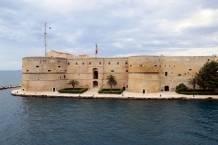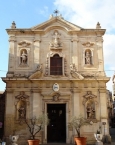Taranto
Worth visiting
Added on 12 Dec 2018,
last edited by »biroto-Redaktion« on 12 Dec 2018
Nearby cycle routes and tours
| Route name | Type | Dist. to route |
|---|---|---|
Route | 0,5 km |
![]()
Please wait - map data are loading
Type of sights
Old town
Name and address
Taranto
IT-74123 Taranto
GEO-data
Geodetic coordinates
40.471306 17.243171
Elevation
28 m
Communication


Taranto (Tarantino: Tarde) is a city on the Ionian coast of Apulia, in southeastern Italy. With 200,000 inhabitants it is the third-largest city of Southern Italy and the second-largest city of the region, after the capital Bari. Taranto is home of one of the most important naval bases in Italy and it boasts a thousand-year-old history, having been one of the most powerful cities of the Mediterranean during the Greek period.
Understand
History
Taranto was founded in 706 BC by Dorian Greek settlers, as the only Spartan colony outside of Greece (the town is still called "the Spartan city"). A legend gives the credit of the city's foundation to Taras (Τάρας) who, according to Greek mythology, was the son of Poseidon and of the nymph Satyrion; after being saved from a shipwreck by riding a dolphin, sent to him by his father, an image visible on many ancient coins.
The city, effectively named Taras, became soon a commercial and militar power of the Ancient Greek world, as well as the most important and inhabited centre of Magna Graecia. Its golden age finished in 272 BC, with the conquest by the Romans, that chose to favor Brindisi as the main port of the Roman Empire.
The town, now called Tarentum, fell in a period of decline and it was later contested between the Lombards, the Byzantines and the Arabs, being attacked and ransacked several times. It was then conquered by the Normans, that made it the capital of the Principality of Taranto, an almost independent feudal fief of the Kingdom of Sicily (and later of Naples), from 1088 to 1465.
The city was later governed by the Monarchy of Spain (for two centuries) and by the Bourbons, that created the Kingdom of the Two Sicilies in 1815. Taranto had a population of about 18,000 inhabitants, all of them living in the small island of the old town.
After the Italian unification, the city became the main base of the newly formed Italian Navy in 1866, and site of important events like the "Battle of Taranto" in 1940, with the victory of the British naval forces against the Italian ones. An enormous steel mill was built not far from the city centre, causing a controversy that lasts still today, making the town famous only for its industry.
Despite this, Taranto is not only a steel mill, but a place worth visiting with an high amount of artistic and historical treasures.
See
Taranto has a beautiful Cathedral and a stunning fishing port, with fantastic theatres, nightlife and gorgeous cuisine- scrumptious! Well worth a visit!
- ⊙Aragonese Castle, Piazza Castello, ☎ +39 0997 753438. 09:30-11:30/14:00-18:00/20:00-01:30.
(updated Jul 2018)
- ⊙Cathedral (Cattedrale di San Cataldo), Piazza Duomo, ☎ +39 0994 707545. 07:30-12:00/16:30-19:30. Free entry.
(updated Jul 2018)
- ⊙Temple of Poseidon (Doric Temple), Piazza Castello. Two doric columns represent the remains of this ancient Greek temple, dedicated to the god of the seas. It dates to the 6th century BC and was unfortunately victim of spoliation during the centuries. The columns stand at 8.47 meters (28 ft) above the ground, in front of the city hall, and they can be admired from behind a gate.
(updated Jul 2018)
- ⊙Church of San Domenico Maggiore, Via Duomo, 33, ☎ +39 0997 07733. Romanesque-Gothic church built in 1302 over the site of a Byzantine church of the 11th century, built, in turn, on an ancient Greek temple. The entry is reachable through a Baroque staircase erected in the 18th century. Free entry. (updated Jul 2018)
- ⊙National Archaeological Museum (MArTA), Via Cavour, 10, ☎ +39 0994 538639. 08:30-19:30. €8 full; €4 reduced; Free up to 18 years and every month's first Sunday. (updated Jul 2018)
- ⊙Spartan Museum (Museo Spartano), Corso Vittorio Emanuele II, 39, ☎ +39 330 438646. Su 11:00-13:00, other days on reservation. (updated Jul 2018)
Useful
Inside the range of 4 km:
- ⊙ Tourist-Information Taranto, Piazza Castello, Taranto
Information about copyright | |
|---|---|
Rights characteristic / license | by-sa: CREATIVE COMMONS Attribution-ShareAlike |
Link to the description of the license | |
Input taken over from: |
Wikivoyage contributors, 'Taranto', Wikivoyage, The FREE worldwide travel guide that anyone can edit, 2 October 2018, 17:23 UTC, <https://en.wikivoyage.org/w/index.php?title=Taranto&oldid=3621773> [accessed 12 December 2018] |
taken over / edited on | 12 Dec 2018
|
taken over / edited by |
|
Nearby cycle routes and tours
| Route name | Type | Dist. to route |
|---|---|---|
Route | 0,5 km |
Added on 12 Dec 2018,
last edited by »biroto-Redaktion« on 12 Dec 2018
